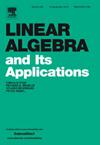具有标记顶点的离散量子行走及其平均顶点混合矩阵
IF 1.1
3区 数学
Q1 MATHEMATICS
引用次数: 0
摘要
研究正则图X上的离散量子行走问题,该问题将负单位元硬币分配给有标记的顶点S,将Grover硬币分配给无标记的顶点S。我们找到了转移矩阵的特征空间的组合基,并导出了平均顶点混合矩阵M的公式。然后我们找到M - M中元素的边界,并研究这些边界何时是紧的。特别地,标记顶点之间的平均概率下界是由诱导子图X[S],顶点删除子图X\S和边缘删除子图X−E(S)确定的矩阵。我们证明,当且仅当标记的顶点在顶点删除子图中具有行走公平的邻域时,该边界才能实现。最后,对于达到此界的量子行走,我们确定M - [S,S]是对称的、正半定的或均匀的。本文章由计算机程序翻译,如有差异,请以英文原文为准。
Discrete quantum walks with marked vertices and their average vertex mixing matrices
We study the discrete quantum walk on a regular graph X that assigns negative identity coins to marked vertices S and Grover coins to the unmarked ones. We find combinatorial bases for the eigenspaces of the transition matrix, and derive a formula for the average vertex mixing matrix .
We then find bounds for entries in , and study when these bounds are tight. In particular, the average probabilities between marked vertices are lower bounded by a matrix determined by the induced subgraph , the vertex-deleted subgraph , and the edge deleted subgraph . We show this bound is achieved if and only if the marked vertices have walk-equitable neighborhoods in the vertex-deleted subgraph. Finally, for quantum walks attaining this bound, we determine when is symmetric, positive semidefinite or uniform.
求助全文
通过发布文献求助,成功后即可免费获取论文全文。
去求助
来源期刊
CiteScore
2.20
自引率
9.10%
发文量
333
审稿时长
13.8 months
期刊介绍:
Linear Algebra and its Applications publishes articles that contribute new information or new insights to matrix theory and finite dimensional linear algebra in their algebraic, arithmetic, combinatorial, geometric, or numerical aspects. It also publishes articles that give significant applications of matrix theory or linear algebra to other branches of mathematics and to other sciences. Articles that provide new information or perspectives on the historical development of matrix theory and linear algebra are also welcome. Expository articles which can serve as an introduction to a subject for workers in related areas and which bring one to the frontiers of research are encouraged. Reviews of books are published occasionally as are conference reports that provide an historical record of major meetings on matrix theory and linear algebra.

 求助内容:
求助内容: 应助结果提醒方式:
应助结果提醒方式:


